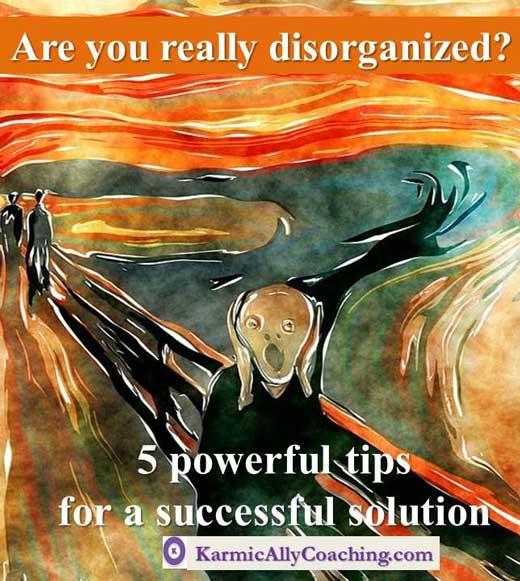
Stress and clutter go hand in hand often feeding off each other to create chaos in a person’ life that can lead to the need for professional help if not dealt with at an early stage.
In Warning inner clutter leads to shiny object syndrome, I mentioned that disorganized space is a reflection of stress a person is experiencing and addressed the role of Shiny Object Syndrome in creating more clutter.
Professionals, who want to achieve goals effectively and efficiently need to learn how to manage stress, clutter and break that mutually supportive feeding frenzy.
In this 4th and concluding post on the topic of Clutter and Stress, we are going to do 2 things – gain an understanding about disorganization and select doable actions to overcome it.
For ease of reference, here is the list of earlier posts
Do You Manage Stress the Clutter Route?
Avoiding Shiny Object Syndrome for Amazing Professional Success
Warning! Inner Clutter leads to Shiny Object Syndrome
There are 2 types of disorganization that can affect us during the course of our life – situational and chronic or challenging disorganization.
An easier way to look at disorganization is from the time period involved.
When your Situation makes you disorganized
Situational disorganization tends to be short-term. Here the clutter is normally the result of life events, transitions and changes.
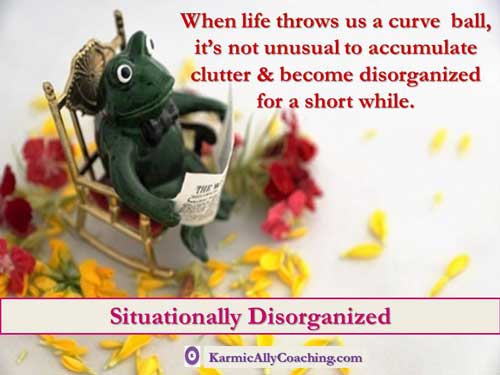
The chaos is temporary until the situation returns to normal or is brought into control with a deliberate action plan to tackle items that were once useful but now create clutter or require some intentional organizing.
A simple example would be relocating to a new city to begin a new job with no time to unpack your belongings or put your belongings in suitable places.
Or a family member falls ill. You have to tend to them during most of your waking hours at the cost of not maintaining the regular routine you might have followed to get household and other work done.
When life throws us a curve ball, it’s not unusual to accumulate clutter and become disorganized for a short while. It happens to everyone.
This is what we call “Situationally Disorganized”: It is a normal side effect of a life situation.
What makes “Chronic Disorganization” different?
The term Chronic Disorganization was coined by Judith Kolberg author of “Conquering Chronic Disorganization” and founder of National Study Group on Chronic Disorganization (NSGCD), coined the term chronic disorganization to describe people who have great difficulty maintaining traditional organizing methods.
The ICD defines chronic disorganization (now called challenging disorganization) as having all three of the following:
- A history of disorganization in which efforts to get organized have not been maintained.
- An ongoing undermining of your current quality of life due to disorganization.
- An expectation that you will continue to be disorganized.
The term “chronically disorganized” is NOT a “diagnosis” or an “illness”.
It is a behavioural pattern and conventional organizing methods designed by other people for the individual will probably not be maintained.
Chronic Disorganization is different from Situational Disorganization because when life transitions happen to you, instead of “recovering” and “restoring order” after a few months or so, the disorganization does not improve and may even continue to worsen over time.
Clutter continues to accumulate and traditional methods of organizing stop working. If the overwhelm is intense, then a person might start to experience chronic procrastination too.
You might also experience periods of extreme organization and then a lapse into overwhelming clutter – like a YoYo. This is also considered being chronically disorganized.
If you experience anger, frustration, guilt about your situation in life and then follow it up with compulsive behaviour like emotional eating, ‘shopping therapy’ or other addictive and or escapism behavior, you might want to take a long look at your situation and consider taking positive action.
If the clutter starts to affect your quality of life, emotional state or mental health, outside intervention might be required. This doesn’t mean that you are ill. It means you need more support to get out of the spiraling situation and in some cases on-going help to maintain a reasonable level of organization.
That said, it is quite common for what started as “situational disorganization” to evolve into “chronic” or “challenging disorganization.”
Are You Chronically Disorganized?
There are a number of reasons why you may be chronically disorganized but the signs are similar.
You may be chronically disorganized if:
- You’ve tried to organize many times but have not been able to stick to a routine or schedule
- You find it difficult to let go of things when you no longer need them or keep them thinking you’ll need it ‘someday’
- Areas of your home (even your garage and perhaps vehicle) are filled with clutter preventing you from using your space optimally.
- Your clutter and disorganization are affecting your health, job, relationships and life in general.
- You participate in free challenges or even paid ones for clutter management and do well during the challenge but then lapse back into old habits because you simply cannot work with an organizing system.
Self-Help suggestions for Organizing when you don’t want to hire help
If you are ambivalent or uncomfortable in hiring help or getting professional assistance whether from a coach, therapist or clutter professional, then there are 5 ways that you can help yourself.
You yourself will know what you need to do after that and take the right call.
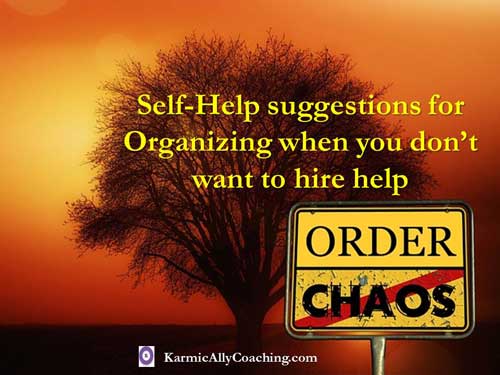
Use your natural tendencies to your advantage
Even the most chronically disorganized person has areas where they are actually organized.
Think of the times when you were at your organized best and the areas where you are actually organized.
What methods do you use in those areas to stay organized? Can they be replicated to reduce clutter and disorganization right now? What improvisations can you make to help you achieve an incremental positive result?
Make this exercise even more powerful by writing it down. When you see the evidence in front of you in writing, it’s easier to get creative and transpose what works in 1 area to another.
It’s also a good confidence building exercise for the task at hand.
Find the right Support Group
Sitting at home or in the office, we often feel we are alone with our challenges whereas there are others who may be fighting the same battle.
Consider connecting with a group of people who are experiencing the same challenge with whom you can meet offline or online in a community setting to support and be supported as you combat your disorganization.
You never know who has had the same experience and can help you with yours. Do a local Google search or check out Facebook Groups. We can all use support!
Practice being decisive – even if it kills you!
This tip might be challenging if you are in the habit of thinking some article or item might come into use later. For example, the cartons of your computer system which you’ve kept in the garage or storeroom thinking you might need it when you shift home or sell it off.
A good way to get started is by disposing off anything you have not used in a year. In other words, those old clothes (especially the ones you’ll never fit into even if you went on a starvation diet or that are out of fashion), broken items that can’t be repaired and duplicate items that can be resold instead of holding onto them in the event you need it.
Remind yourself that many items are easily replaceable if you need them later.
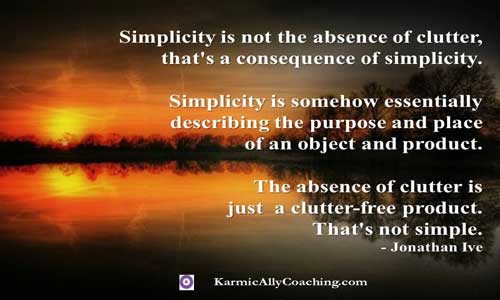
Schedule de-clutter time into your daily schedule
There’s truth in the saying that a journey of a thousand miles begins with 1 step/
Likewise, pencil in 15 minutes a day to do a spot of de=clutter instead of thinking you need a whole day to do it.
A good way to get into the habit of clutter management is to start small. For example Do a drawer or desk one day, the kitchen shelves the next day and the laundry room the next day.
An even better way is to sign up for the 21 Day Declutter Challenge where we do both the outer de-cluttering and the inner work to make sure you rid yourself of the clutter.
The best part about this challenge is that you can return to it again and again whenever you feel yourself slipping and want to do a spot of de-cluttering.
Learn more by clicking on the image below.
Guard your sacred space from invading clutter
Would you allow anybody off the street into your home? I would think not!
Using the same principle, think twice about what you allow into your home. Wait a couple of days after seeing a new item before you buy it (it helps combat Shiny Object Syndrome too). If and when you do purchase something new, discard another item you own to make room for it.
Master the OHIO rule: Only Handle It Once
This tips works for productive work and fits the bill when trying to organize your home, office and anything that needs to be organized.
If you pick something up, make a decision then and there about it, and either put it where it belongs or discard it. Don’t fall into the trap of moving things from one pile to another, again and again.
Last but not least, learn to honor your space. Treat it with respect and it will in turn nourish you and help you live a peaceful life.
Are you organized? How do you stay on top of your space?



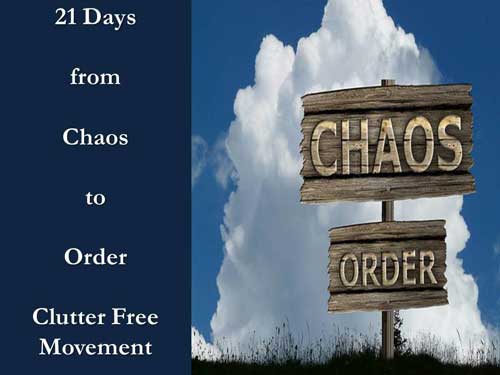

 I adhere to the Certified Coaches Alliance Code of Ethics and Standards. A copy is available on request.
I adhere to the Certified Coaches Alliance Code of Ethics and Standards. A copy is available on request.
 Let's Talk through the Connect Form:
Let's Talk through the Connect Form: